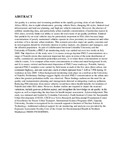| dc.description.abstract | Air quality is a serious and worsening problem in the rapidly growing cities of sub-Saharan Africa (SSA), due to rapid urbanization, growing vehicle fleets, changing life styles, limited road infrastructure and land use planning, and high per-vehicle emissions. However, the absence of ambient monitoring data, and particularly urban roadside concentrations of particulate matter in SSA cities, severely limits our ability to assess the real extent of air quality problems. Emitted fine particles by on-road vehicles may be particularly important in SSA cities because large concentrations of poorly maintained vehicles operate in close proximity to commercial and other activities of low-income urban residents. This scenario provokes major air quality concerns and its investigation should be of priority interest to policy makers, city planners and managers, and the affected population. As part of collaboration between Columbia University and the University of Nairobi, a PM2.5 air monitoring study was carried out over two weeks in July 2009. The objectives of the study were 1) to assess average daytime PM2.5 concentrations on a range of Nairobi streets that represent important hot-spots in terms of the joint distribution of traffic, commercial, and resident pedestrian activities, 2) to relate those concentrations to motor vehicle counts, 3) to compare urban street concentrations to urban and rural background levels, and 4) to assess vertical and horizontal dispersion of PM2.5 near roadways. Portable, battery-operated PM2.5 samplers were carried by field teams at each of the five sites (three urban, one commuter highway, and one rural site), each of which operated from 7 AM to 7 PM during 10 weekdays in July 2009. Urban background monitoring took place on a rooftop at the University of Nairobi. Preliminary findings suggest highly elevated PM2.5 concentrations at the urban sites where the greatest pedestrian traffic was observed. These findings underscore the need for air quality and transportation planning and management directed at mitigating roadway pollution. Reducing PM emissions from motor vehicles would have direct health benefits for residents of Nairobi and other SSA cities. However, further studies are required to depict the seasonal variations, include gaseous pollution aspect, and strengthen the knowledge on air quality in the region as well as improving the data base for health impact assessment. Acknowledgement This study was initiated and funded by Columbia University's Earth Institute's Center for Sustainable Urban Development (CSUD). CSUD is a Volvo Research and Educational Foundations Center of Excellence for Future Urban Transport. International Science Programs (ISP), Uppsala University, Sweden is recognized for its research support to Institute of Nuclear Science & Technology. Additional technical support for air monitoring and analysis was provided by the Exposure Assessment Facility Core of the Center for Environmental Health in Northern Manhattan (NIEHS P30 ES09089). | en_US |

